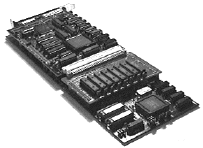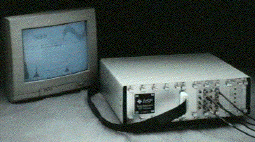Real-time Processing in Digital Audio and Electroacoustic Applications
by Graziano Bertini
Sound synthesis/processing algorithms and programmable real-time multi-DSP systems for audio and musical signals are currently being studied and developed at the Istituto di Elaborazione dell'Informazione (IEI-CNR). The aim is to obtain original solutions to problems in the computer music field and to support applications in the electroacoustic and audiometric fields.
Research activity in the digital signal processing (DSP) area began in the Signal and Image Processing Department of IEI-CNR at the beginning of the 90's thanks to the commercial availability of cheap and powerful integrated devices for DSP. This activity has taken advantage of previous experience acquired at the department in the development of mixed analog-digital systems for the synthesis of musical signals and the analysis of biomedical signals. It is conducted jointly with the Computer Music Department of CNUCE-CNR (Pisa) and in collaboration with designers of SEED (Studio of Electronic Eng. & DSP, Massa, Italy third party for Texas Instruments). The main objective of our industrial partners is to improve system performance and cost/performance ratio in professional and consumer digital audio and to design DSP apparatus for electroacoustical, telecom and industrial applications.
Collaborations and contacts are also active with: CIARM (Centre for Acoustics and Musical Research, Ferrara, Italy), IRIS (Institute for Industrial and Entertainment Research, the Bontempi-Farfisa group, Frosinone, Italy), and GEM (Generalmusic, Rimini, Italy).
The strategy adopted is to support many types of applications using a limited number of platforms (see below), changing only the algorithms and/or the I/O interfaces.
 |
 |
| Control Board SEEboarD TIC25-50 and processing board SEEboarD TI C31-27 | MCH8: synchronous acquisition/generation system |
The design procedure is the following:
- the setting-up of a hardware/software integrated development system environment (generally consisting of a PC as host computer with special add-on hardware and high level software tools) in order to test many specific applications and to evaluate the design requirements of the target systems
- the definition of hardware/software subsystem specifications for the realisation of apparatus: (size of memory, type of DSP core, analog and digital I/O, type of interface with the host computer, etc.).
The hardware realisation of the prototypes is done using the facilities of the electronics laboratory of IEI-CNR; the software is mainly developed by SEED. Here below, we briefly describe two of the platforms developed.
Harvest-MCH8
In recent years, in the field of noise and vibration control, much attention has been paid to achieving attenuation through active electronic techniques, in addition to conventional methods. This is due to the massive development of VLSI devices that have adaptive control and filtering feasible in real-time mode. Active noise control (ANC) in real applications is a complex multi-disciplinary problem. Efficient design requires powerful simulation tools as well as high performance signal acquisition and real-time processing facilities.
Typical problems encountered in these applications are the multichannel acquisition and rendering of signals with stringent time correlation constraints, such as phase delay jitter etc. To satisfy these and other requirements, a modular programmable system has been developed, which can perform a simultaneous acquisition of up to eight channels. The Harvest-MCH8 consists of a host computer PC (IBM compatible) and three sub-systems:
- the MCH8 part of the system with high-performance signal conditioning and a 16 bit AD-DA conversion circuit, plugged into an euro-card cabinet
- a proprietary DSP board (SEEboarDTI 25-50) which interfaces the MCH8 apparatus with the host
- a floating point DSP module placed as piggy-board on the SEEboarD which provides the computational power for real-time processing.
The Harvest-MCH8 system can be used as a platform for evaluating adaptive algorithms in an experimental set-up, as well as a target system in those applications where a host PC environment is required, such as in the measurement/generation of acoustic functions and vibration analysis/testing.
SEExoverD
In the digital audio field, a multimicro system has been built based on one general-purpose microDSP, two special DSP (ie TMS 57002, DASP-Digital Audio Signal Processor by Texas Instruments) and other modern interfaces (stereo sigma-delta codecs, AES/EBU digital interfaces etc.). The system can operate in stand-alone mode and can implement a number of synthesis/ processing algorithms stored in a EEprom. It can also be fully controlled by a host computer via a standard RS232 serial link; under Windows, the user can implement and evaluate his own processing algorithms. All the software of the Texas TMS320C2x DSK Starter Kit can be used.
Typical applications are the following: narrow band equalisation, active sound control filtering in sound reinforcement systems, base band processing in FM telecom stations, experimental audio-metry, etc.
Please contact:
Graziano Bertini - IEI-CNR
Tel: +39 50 593400
Fax: +39 50 554342
E-mail: bertini@iei.cnr.pi.it
Michele Marani - SEED
Tel: +39 585 792990
Fax: +39 585/792989
E-mail: mcl4453@mclink.it
